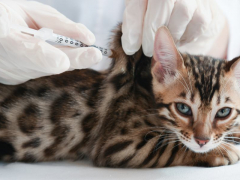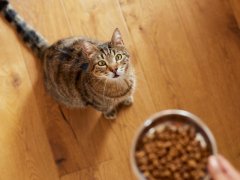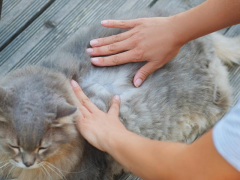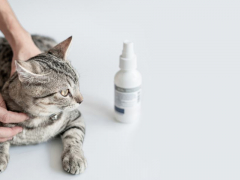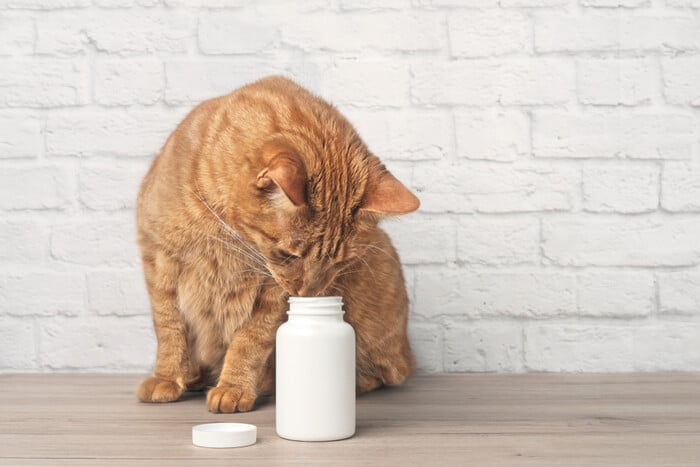
Clavamox is a common antimicrobial antibiotic prescribed for a variety of bacterial infections in cats and dogs. The name Clavamox is a brand name for the generic antibiotic amoxicillin/clavulanate potassium or amoxicillin/clavulanic acid.
Clavamox For Cats Overview

In this article we’ll talk about what Clavamox is, what it does, and some other useful info about dosing and safety.
What Is Clavamox?
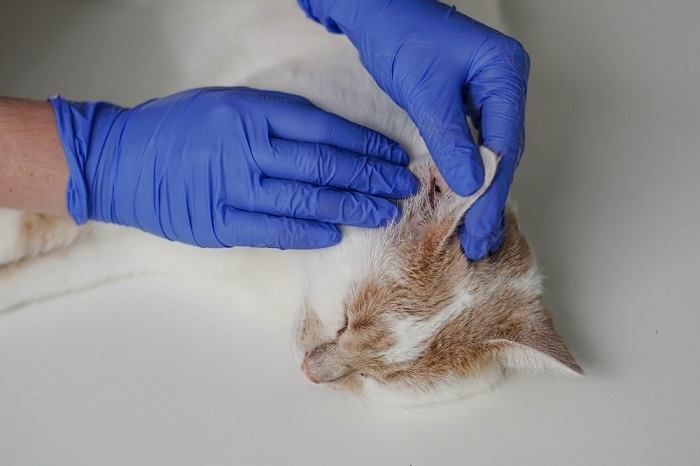
Clavamox is what is called a potentiated penicillin antibiotic. Because of the addition of clavulanate, it can have a broader range of effect compared to plain old amoxicillin and can inhibit something called beta-lactamase, which some bacteria can produce to resist some antibiotics.
Clavamox is typically used for infections of the urinary tract, skin infections, and various infections of the soft tissues such as bite wounds.
Veterinarians also widely use Clavamox for respiratory infections as well. Because there are many different types of antibiotics out there, a veterinarian will decide which one is most appropriate to use for a particular patient.
What Does Clavamox Do for Cats?
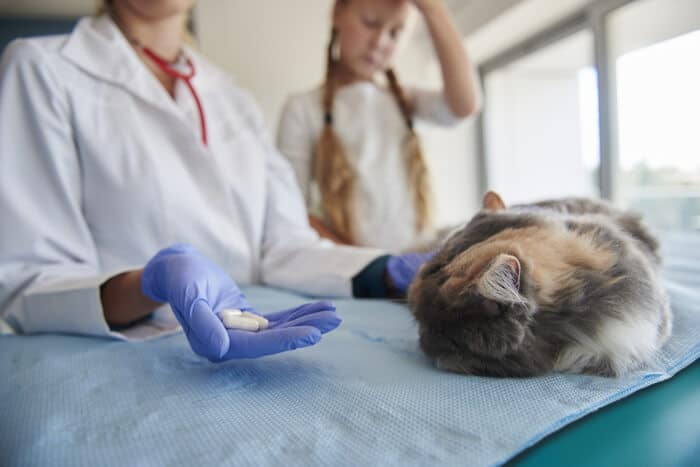
Clavamox kills bacteria associated with infections like upper respiratory infections, urinary tract infections, and soft tissue infections associated with bite wounds and other injuries.
As a bactericidal antibiotic, the role of Clavamox is to kill bacteria that are susceptible to it. In kitty cats, it is most often used for upper respiratory infections, urinary tract infections, and soft tissue infections complicating a bite wound or injury.
Clavamox works by binding directly to certain enzymes located in the cell membrane of susceptible bacteria, inhibiting the development of the cell wall and making the bacteria unstable, thus killing them.
It’s very important to note that Clavamox is not effective against viral infections, a common cause of upper respiratory conditions in cats. Therefore, it’s always important for a vet to decide if the use of an antibiotic is warranted.
Side Effects of Clavamox for Cats
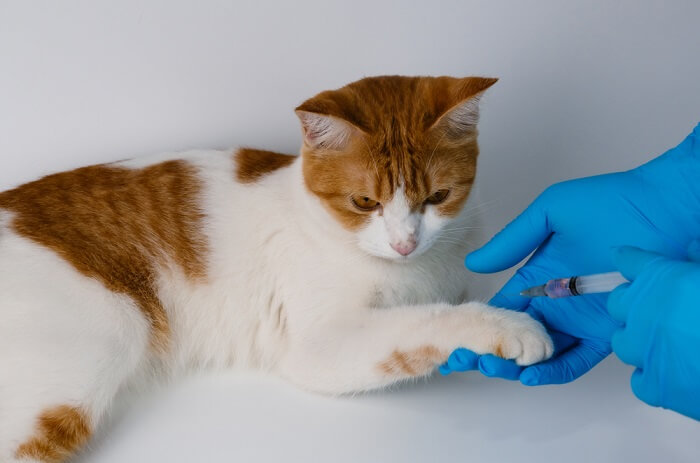
Fortunately, side effects of Clavamox in cats are typically mild and self-limiting. The most common seen is digestive upset in the form of decreased appetite, vomiting, and/or diarrhea.
As a broad-spectrum antibiotic, Clavamox can affect and alter the normal and beneficial bacteria living in the gut, which is often the cause of diarrhea if it occurs.
In many cases, ensuring Clavamox is given in close association with a meal can help to offset stomach upset. If this still occurs, discontinuing Clavamox often leads to resolution of the side effects, but should always be done under a vet’s advisement, especially if Clavamox is being used to treat an infection.
If a mild diarrhea develops, use of a probiotic at your vet’s discretion is sometimes helpful. Otherwise, mild side effects may need to be endured if a more serious infection is being successfully treated.
However, if your kitty stops eating, it is very important to tell your vet, since some cats can develop a very serious secondary liver condition from prolonged inappetence alone.
It is extremely rare but possible to see allergic reactions to Clavamox including hives, rashes, fever, and resulting abnormalities in red and white blood cell counts.
For the rare cat this might occur with, any dose could induce these effects and these effects are not dose-dependent. In other words, if your furry pal does well with a prescribed dose, and an extra dose is given accidentally, there is no higher risk for one of these allergic reactions to occur.
Clavamox for Cats Dosage

The published dosage for cats is 62.5mg per cat every 12 hours. However, it’s important to note that the dosage may differ depending on the type of infection being treated as well as a cat’s size or body weight.
Certain kitties that are either very small, like young kittens, or very large kitties suffering from obesity may be prescribed a different dose at a veterinarian’s discretion.
Dosage Forms of Clavamox for Cats
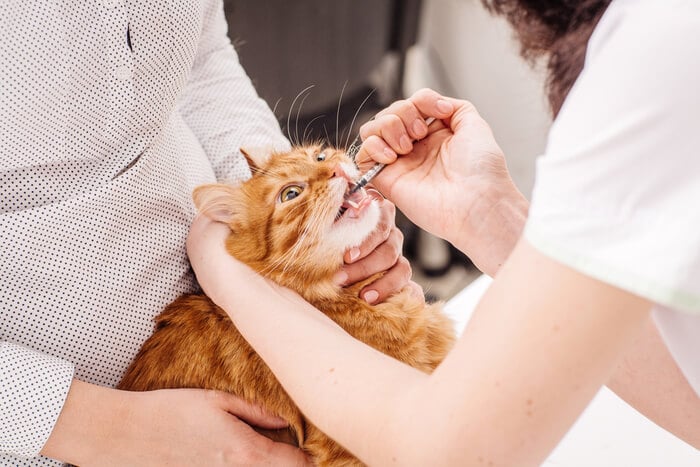
There are a couple of different forms of Clavamox for cats. You or your veterinarian will choose between an oral suspension liquid or tablet form.
Clavamox comes in both an oral suspension liquid form as well as a tablet form. Your veterinarian may have a preference of which form to use, or may leave the dosage form up to you depending on which will be easier to administer.
If your kitty will take a pill mixed with or hidden in food or a treat, this is often easiest and involves the least amount of struggle.
However, if your furry friend is the type that will eat everything in the bowl but the tablet and leave it at the bottom, you may need to consider liquid if you are not adept at administering a pill directly into your cat’s mouth for her to swallow it.
There are both chewable and non-chewable forms of the tablet. Some kitties may take the chewable form as a treat or hidden in food, making dosing much easier.
However, because some cats can certainly be very picky about what they eat, you may find you have to administer the chewable tablet directly or consider the liquid form.
The tablets typically come in sealed blister packs to protect them, as the clavulanic acid portion is considered more susceptible to moisture.
For this reason, it’s important not to open the blister until you’re ready to give the medication. In the same vein, it is typically recommended not to split Clavamox tablets because the second tablet half will then go unused for many hours.
The liquid form typically needs to be refrigerated. It is often reconstituted with water at your vet’s practice when you receive it. If your vet prescribes two boxes, they should provide you with instructions on how to mix up the second bottle.
The instructions to do this are also typically printed on the side of the box. Because liquid Clavamox should be discarded after 10 days, it is important not to mix up a new bottle until you are ready to use it.
If a reconstituted bottle of Clavamox has been sitting out at room temperature, it may need to be discarded depending on how long it has been out, usually after a few hours. But it’s always best to give your vet clinic a call before just throwing it away.
Clavamox vs. Augmentin
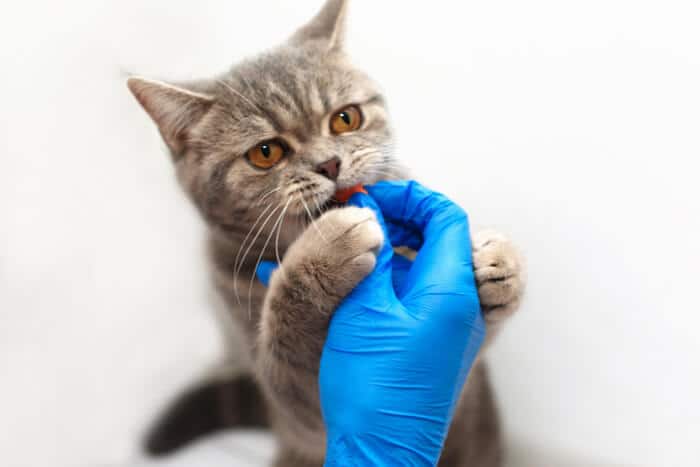
Some human-intended medications contain the same antibiotic found in Clavamox, but the dosage of Augmentin is different.
Generic medications are a popular and sometimes less-expensive alternative pet parents are interested in. Amoxicillin/clavulanate does have another brand dispensed to humans, called Augmentin.
But while they contain the same antibiotic, it is very important to understand that the dosage forms of Augmentin and Clavamox are very different, which is sometimes confusing for pet parents.
Veterinary preparations of amoxicillin/clavulanate like Clavamox have dosages expressed as the total of both the amoxicillin and clavulanate components, whereas with Augmentin and generic human forms, the dosage is typically expressed only as the amoxicillin dosage. Therefore, 125mg of Augmentin is not the same thing as 125mg of Clavamox.
For kitties, Augmentin tablets may be impractical, as the lowest dosage tablet available is double the recommended dosage for most cats (i.e. 62.5mg tablets of Augmentin do not exist). For these reasons, your veterinarian may insist on prescribing a veterinary preparation like Clavamox for your feline friend.
Concluding Thoughts on Clavamox
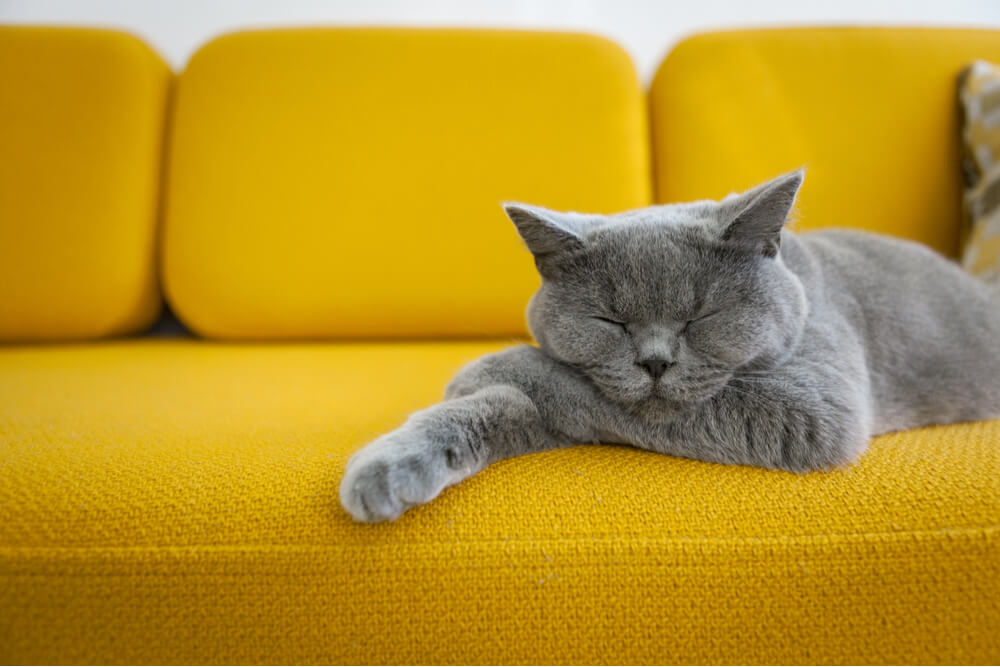
Clavamox is truly one of the “hardest-working” antibiotics we have available in veterinary medicine and one of the most widely-prescribed for cats.
However, it’s really important to make sure it is only used when dispensed or prescribed by a veterinarian, and that all prescribing instructions are followed.
Indiscriminate use of any antibiotic can lead to resistant bacterial populations, which makes treating infections more difficult. Always make sure to give an antibiotic prescribed by your vet for the full number of days indicated, even if your kitty looks like he’s feeling better.
Drug Dosing Disclaimer: We are only able to provide doses for medications that are FDA approved for use in cats and only as the label guidelines dictate. For medications that are used off-label we can only provide guidelines and safety information for use. Safe and appropriate dosing for off-label medications can only be determined by a primary care veterinarian.
We encourage you to work with your veterinarian to determine if a particular medication is appropriate for your cat. Changing or adjusting a dose for your cat on your own without consulting with a veterinarian can carry risk. We do not encourage use of medications prescribed for human use in pets without first consulting with a primary care veterinarian.
